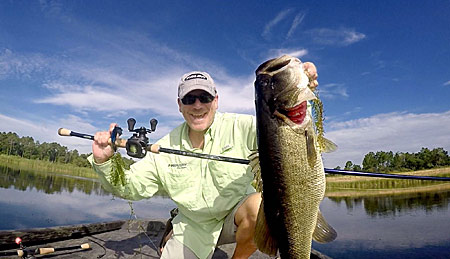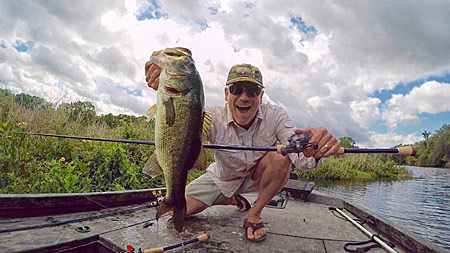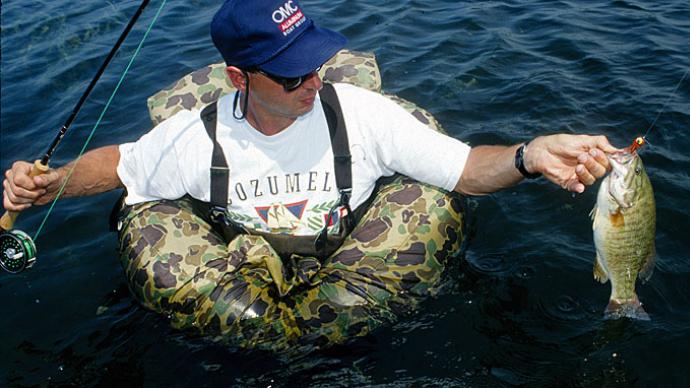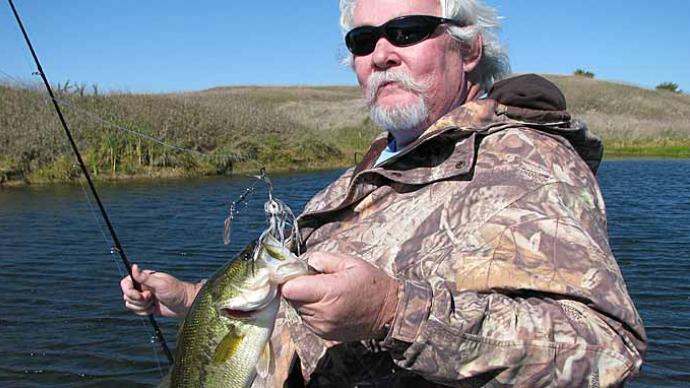
One of the most recent bass fishing trends has been using longer rods. The Bass Master Elite series now allows rods up to 10 feet. In the past, rods longer than 8 feet were not allowed. MLF does not have a rod length limit at this time. The real question is, what advantage or disadvantage do longer rods present?
“25 years ago, the average rod was 5-1/2- to 6 feet,” shared avid bass angler Joe Balog of Millennium Promotions Inc. “A typical rod is now probably 7 feet with the average being between 6-1/2 to 8 feet. I don’t think I own a rod shorter than 7 feet. Well, maybe one, but I don’t use it. There are just limited applications for shorter rods.”
Longer rods offer a considerable advantage when fishing open water, using lighter line, and making long casts. Long rods can move more line when setting the hook, too.
Balog told of a demonstration he used to do when putting on seminars at sports shows. He would take a 5-1/2 foot rod, flip a bait out on the floor, and point the rod straight at it. He’d then lift the rod to the 12 o’clock position and tell the audience to note how far the bait moved. Then, he’d do the same thing with a 7-foot rod and have them note how much farther the bait moved with the longer rod. The demonstration illustrated how much more line you could pick up with a longer rod. This equates to hook-setting power. Imagine how much more line you could pick up with an 8- or 9-foot rod and the corresponding hook-setting muscle.
Longer rods are not the end-all to catch-all, though. Long rods can be unwieldy, cumbersome for fishing moving baits and for hitting shallow targets. You can also lose some accuracy with long rods. “There are still limited applications for shorter rods,” admitted Balog.
Longer rods excel when making long casts with crankbaits, achieving and maintaining maximum depth, keeping the proper angle when fishing jigs and tubes, and allowing continued contact with the bottom.
To take advantage of the greater casting distances afforded by longer rods, you need to have them paired with the right reel. Longer spinning rods must be matched with reels with more line capacity and deep, long-cast spools to achieve maximum distance. The same thing applies to bait casters.

I learned about the advantages of using longer rods when fishing steelhead a long time ago. Long, 9- to 10-1/2-foot steelhead rods made long drifts possible while keeping the maximum amount of line out of the water to get a drag-free float and to drive the hook home when you had a lot of line out. The long, limber rods also acted like a big shock absorber and made it possible to land wild rainbows that often topped double digits with 4- to 8-pound-test line. Longer rods offer bass anglers similar advantages.
One reason longer rods are becoming more popular with bass anglers is that modern technology and materials have made it possible for manufacturers to make rods that don’t feel like a war club, are super responsive, and won’t explode the first time you set the hook. “The whole manufacturing process is much different now than it was just a few short years ago,” claimed Balog. “Manufactures now lay rod-building materials in different directions and configurations. This allows for increased tinsel strength that allows the fabrication of rods that are less fatiguing, lighter, don’t overpower the lure, and allow anglers to cast further with more line control, with better hook setting power and flex that’s better for fighting fish.”
When Balog was a Great Lakes guide targeting brown bass on the tournament trails, his ace-in-the-hole was longer spinning rods. However, now that he has migrated to Florida, the ballgame and his rod requirements have changed. “I’ve been working with St Croix Rods to develop and test new rods that fit the way I’m fishing. I wanted a longer rod for flippin’ and pitchin’ and catching big bass out of heavy cover. I fished for six months with rods that featured different tapers and lengths, looking for just the right bend and flex to handle big baits before I found one that I knew would be a game-changer.”
Balog’s field testing came up with the new St. Croix Legend Tournament 8’11” Flippin’ / Punchin’ Rod LBC811HMF. “The new rods will be on the site soon,” he said. “I caught hundreds of big largemouths on the new rods fishing heavy cover and never had a failure.”
Balog said the new longer rods excel in several areas. “The longer rod helps in matted vegetation,” he said. “It facilitates lifting the lure, line control, and keeps the bait at the proper angle,” Balog said. The longer rod allows him to hit spots more accurately, more precisely, and with an accelerated presentation.
‘The other thing that the longer rod excels at is hook setting in heavy cover,” he explained. “Most huge bass are lost in the first two seconds. With these rods, you can make two or three cranks and quickly get the fish up and coming out of the junk. The rod gives you more leverage. With a longer, stronger, more sensitive rod, you can physically move the fish to get him away from cover. Once you have the fish away from cover, your chance of landing it increases dramatically.”
About the only drawback of longer rods might be storage. “Most boats these days have rod lockers that can accommodate longer rods,” said Balog. “The longer rods are one-piece rods. You might think that a telescopic rod would be the way to go, but to make a telescopic rod requires more material, which adds weight, and they don’t flex like a one-piece rod.”




